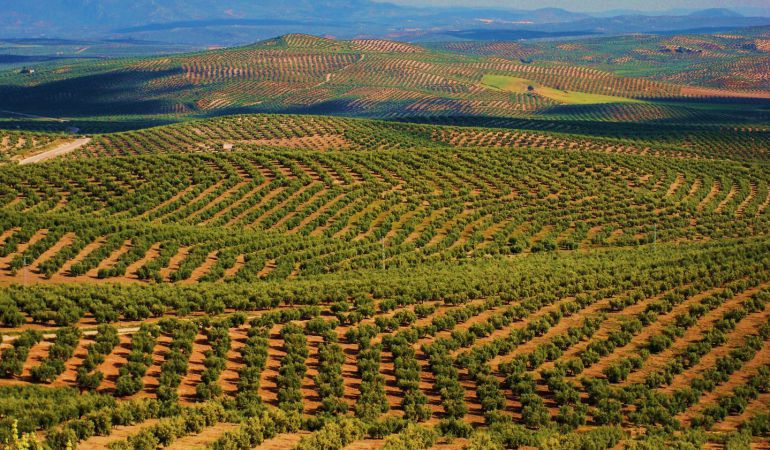Drought and high temperatures sentence Andalusia to “the worst agricultural year of the century”
- Agricultural organizations warn of losses at the end of 2023 due to the drop in olive production by half and the longest drought since 1961
- The agricultural sector in Malaga closes the worst year of the century and faces a historic reform

Olive fields in Andalusia
The past year has been disastrous for Andalusian agriculture and livestock. The agricultural organizations agree on their balance, with very negative effects for the Andalusian countryside. The annual balance report of the Union of Small Farmers in Andalusia (UPA) speaks of the “worst agricultural year of the century”. There have been four consecutive years in which rainfall is well below the historical average.
The general secretary of UPA Andalusia, Cristóbal Cano, highlighted in the balance the harmful effects of the anomalous temperature regime, the persistent drought or the drastic decrease in irrigation supplies that has conditioned the campaigns and costs that continue to make many farms unviable. especially livestock. The autumn rains have been “timely, although scarce” for sectors such as winter cereals, horticulture or the improvement of pastures “but they arrive too late for most crops.”
“It has been a more than complicated year for Andalusian agriculture,” says Cano, “365 difficult days.” “To the delicate situation due to the rise in generalized costs, the energy crisis and the rise in interest rates that are having an impact on the income statement of Andalusian agricultural holdings, are added the effects of abnormal temperatures, extreme drought, which is the longest since 1961, according to Aemet, that the Andalusian countryside has endured, despite the long-awaited rains that are appearing in dribs and drabs, and high prices for the consumer that, in most sectors, do not imply sustainability. economic of our farms,” says the head of UPA Andalucía.
The Andalusian Government estimates the impact of the drought on the growth of the Andalusian economy at 2.1 points, due to the weight of the primary sector and the industry and services linked to it in Andalusia (which is around 25%). .
olive crash
The balance of the Asaja employers’ association does not differ anything from this harsh portrait. The agrarian organization has reviewed the provinces and, without a doubt, the olive grove production, with Jaén as the main victim. The year ends with a bad olive oil campaign in Andalusia and therefore in Spain. In the Andalusian community, 579,675 tons were produced, while in the country there were 665,000. “A very bad harvest if we compare it with that of 2022, which closed with 1,156,000 tons in Andalusia and 1,482,000 nationally,” confirms UPA. The figures contrast with the average achieved in the last five years. In the 2018 and 2019 campaign it reached close to 1.8 million tons in Spain.
The drought wreaks havoc on the olive grove but also the unbearable heat of spring, at the most delicate moment for the olive grove, such as flowering. It was then, with temperatures that reached 30 degrees, when the setting of the olive was greatly affected, since the strong heat burned a large part of the flower.
From Asaja Jaén they regret that for the second consecutive year they face a campaign of declining production, “at the same time that the rise in wage costs, the increase in the cost of fertilizers, phytosanitary products, seeds, plastics, diesel and electricity, among other inputs, has meant an increase in production costs of more than 35% in 2022.” This increase “is not at all compensated” by the record price that olive oil has reached in recent months, they point out from this organization, which also criticizes that “the CAP compensations have been reduced for the Jaén countryside,” accusing the Minister of Agriculture, Luis Planas, for having “caused the transfer of 500 million euros of European aid from Andalusian farmers and ranchers to those in other regions.”
The UPA disagrees with that reading. Its manager in Andalusia, Cristóbal Cano, showed the satisfaction of his organizations because “the first year of application of the new CAP brings concepts that did not exist before to make a more fair and social distribution, such as redistributive payment, ceilings maximum aid or the associated aid for traditional olive groves and raisins.” In the positive balance, they also highlight the agreement for Doñana reached by the Board and the Government “which gives stability to farmers.”
Good year for tomatoes
The effects of Russia’s war against Ukraine seem to be “little by little receding,” these organizations point out, “although much more slowly than it arrived.” “Input prices always rise like a rocket, but fall like a feather,” warns the UPA spokesperson.
The Asaja employers’ association in Malaga, chaired by Baldomero Bellido, also assesses “a resounding drop in turnover”, with “a decrease of 50.5 million euros compared to 2022, which was already the lowest of the previous 10 years.” , going from billing 701.55 million to 651.04 million euros. “We continue with the same problems as in the previous campaign, in which the absence of rain and the lack of infrastructure to store the little reserve we have continue to be two of the main obstacles for farmers and ranchers,” said Bellido.
In Almería, Asaja gives the best balance in all of Andalusia, ensuring that the year was “positive in the income section for a large part of the fruit and vegetable farms.” Products such as tomatoes in all their varieties have improved their position, recovering, so far, part of the cultivated area lost in previous years. Thus, the surface area of tomato and pepper crops is stabilized, leaving the greatest growth in zucchini and cucumber. However, the watermelon did lose surface area in spring due to the lack of water for irrigation in the Levante area, reports the Almería employers’ association.
Source: La Opinión DE MÁLAGA